 October 6, 2011
October 6, 2011 Spotiwhy? : Are Subscription Music Services a Sustainable Business Model?
Subscription music services have been dominating the news recently with the U.S. launch of Spotify and the new IHeartRadio, plus free offerings from MOG and RDIO, and the recent purchase of Napster by Rhapsody. There is a sea change occurring in all content industries moving towards streaming and subscription rather than ownership, and this transition has been causing a lot of debate and disagreement about the potential and the fairness of this new model of consumption.
Spotify has been both the most visible and the most vilified of the new companies. First there was the public removal of certain labels’ catalogs from the service. Since then, there has been a rash of artists making their royalty statements public in an effort to show that Spotify is not a viable business partner for a small label or an indie musician. Because these numbers exist in a vacuum there is no way to gauge if these are isolated instances or a pervasive injustice. Spotify’s response has been equally vague, referencing aggregate payouts instead of the individual ones that are being questioned.
There have been a lot of individual experiences and accounting being bandied about, but I have yet to see any hard macro numbers. Looking at all of this I decided to do some analysis into what the potential of subscription music is in the United States. Because of the nature of subscription services it is not necessary to focus on just Spotify. In aggregate all subscription music can be looked at in the same way as long we assume the services charge the same per month per user.
This essay is neither for nor against subscription music services, and will focus on answering four questions.
1) What is the revenue potential for subscription music services?
2) What are the most likely rates per stream?
3) How much money can an artist expect to make from subscription music?
4) Is a compulsory rate a sustainable business model?
What is the revenue potential for subscription music services?
This is a fairly straightforward calculation. The formula for the total possible revenue in a month is the number of accounts using a subscription service multiplied by the monthly cost of the service.
TMR = A x C
The resulting number multiplied by 12 months will give the yearly revenue potential. Using the last accounting of roughly 115 million U.S. Households and an assumption of a 9.99 monthly cost, the total possible revenue for a subscription music service is roughly 13.75 billion dollars.
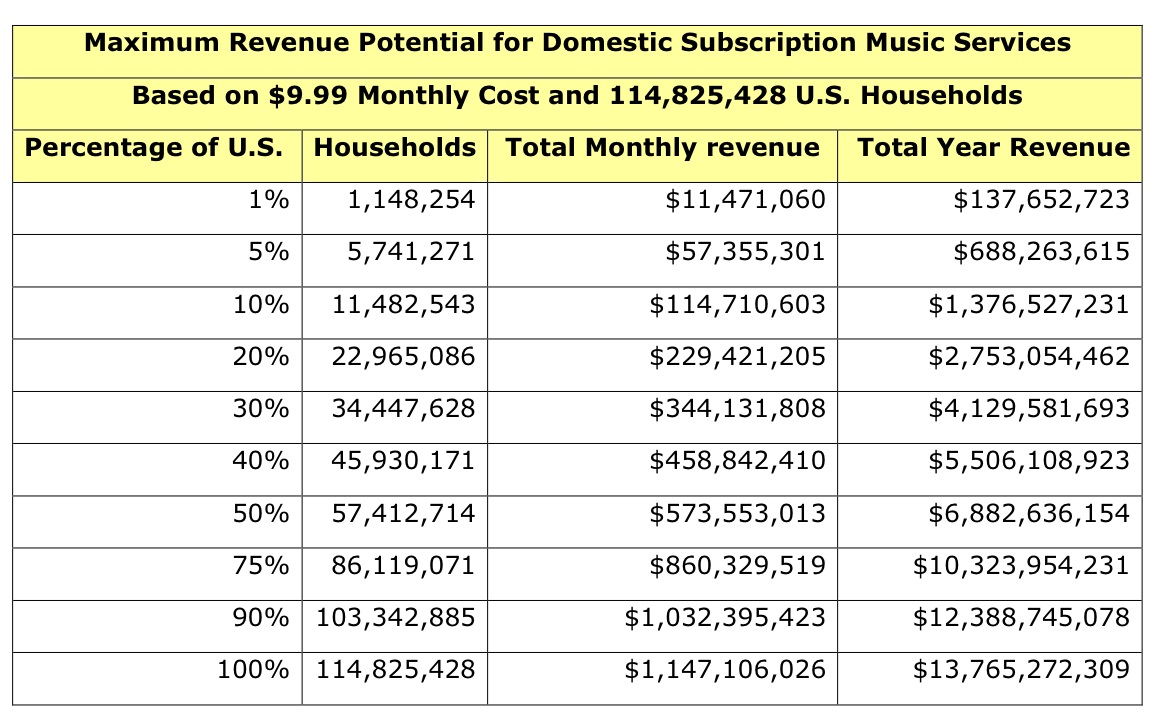
In 1999 at the height of the CD boom sales of recorded music totaled 14 billion dollars. In theory, subscription music’s 13.75 billion dollar potential returns the music industry to its glory years. It is unlikely though, that paid subscription music will reach 100% household penetration in the near future. Currently Spotify has somewhere between 1 and 2 million paying customers. The combined Rhapsody and Napster, which I’ll tentatively refer to as Rhaspterdy, has about the same. Add in MOG, RDIO and other miscellaneous competitors and the current subscription music base is most likely between 4 and 5 million paid users or approximately 600 million in yearly revenue.
Netflix, which has been the most successful paid subscription model, has roughly 25 million subscribers. If subscription music can reach that same level of cultural adoption then it will generate about 2.75 billion dollars in revenue at critical mass. If all 66% of U.S. households with broadband have a subscription music account then the total revenue will be about 9 billion dollars. These large numbers may seem impressive, but they actually have very little influence In terms of the rate per stream.
What are the most likely rates per stream?
There have been numerous instances where artists have released their royalty statement to show what appears to be paltry payment for streaming. Spotify’s recent assertion is that once the revenue goes up, increased payments will follow. This is obviously true in the aggregate as there is more money, but many people seem to think that this will also result in higher royalties per stream. After running the numbers, I believe this is highly unlikely.
The total revenue will be divided in two ways. The first division is the percentage split between the subscription service and the artist revenue pool. The calculations in this essay are modeled on an assumed 50/50 split for this pool, because I’m a fair guy. The second division is how the artist revenue pool will be split between the individual artists and labels. This is the payment per stream.
In order to know the potential payment per stream, or from the services viewpoint, the cost for each stream handled, the first step is to calculate the total number of streams that a service will stream.
If it is assumed that songs last 3 minutes on average, then a user will stream 20 songs an hour. Extrapolating this formula, a user can stream a maximum of 480 songs a day, and 14,400 songs a month. It is not likely that every user will listen to music twenty-four hours a day. According to a Kaiser Family Foundation study entitled Generation M; the average American teenager listens to 2.5 hours of music a day. This seems like a reasonable number to use as the listening baseline for a subscription music user.
The following table shows the amount of streams a subscription service will handle per month at both constant usage and the average 2.5 hours of listening.
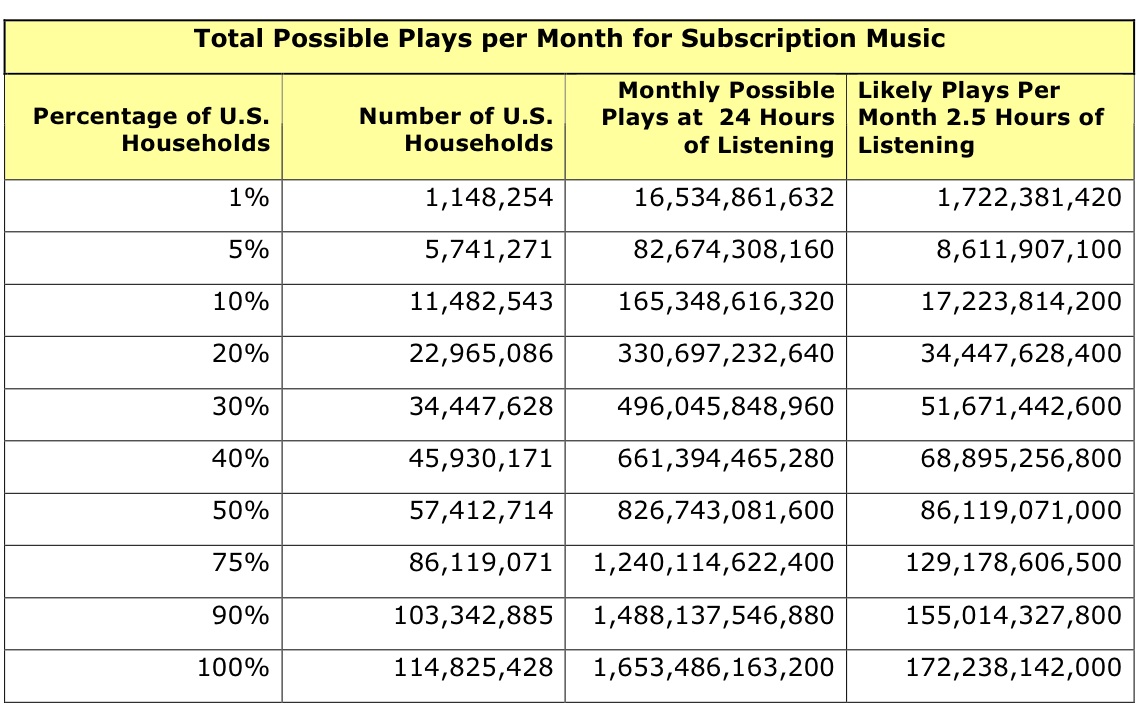
The two variables necessary for the division of the revenue pool based are now calculated. These are total revenue and total streams. My formula is based on a perfectly even division of revenue based on percentage of total plays a song comprises, because again, I’m a fair guy. The actual formulas the services use are probably slightly more complicated, but the basic concept should be the same.
Stream Payment Formula:
1
__________________ X Revenue Pool = Payment per stream
Total Plays
1% of U.S. Households using subscription music at 2.5 hours of listening a day.
1
__________________ X 5,735,530 = $.0033
1,722,381,420
20% of U.S. Households using subscription music at 2.5 hours listening a day.
1
__________________ X 114,710,603 = $.0033
34,447,628,400
The interesting thing about this equation is that because plays increase by the same factor as revenue, the ratio remains the same. The per-stream royalty is still the same 1/3 of a penny. There are two ways to increase the per stream royalty. The first is the per-stream royalty will increase if as more people adopt the service the number of plays decreases as they do. This would require the service to be used less as it gets more popular. This is the gym membership model. The per-stream royalty can also increase if the distributed revenue increases. This is possible if the overhead required to run a subscription company does not increase at the same rate as subscriber acquisition, and the extra money is added to the revenue pool.
After doing this calculation for numerous plausible scenarios, I’ve found the per-stream payment is almost always a fraction of penny. This will always be the case when dividing millions in revenue by billions of streams or billions in revenue by trillions of streams.
What can an artist or label expect to make from subscription music?
If the per-stream payment is a fraction of a penny, what does that mean for a song’s total revenue potential? To illustrate this the following table looks at potential aggregate payouts at 3 tenths of a penny.
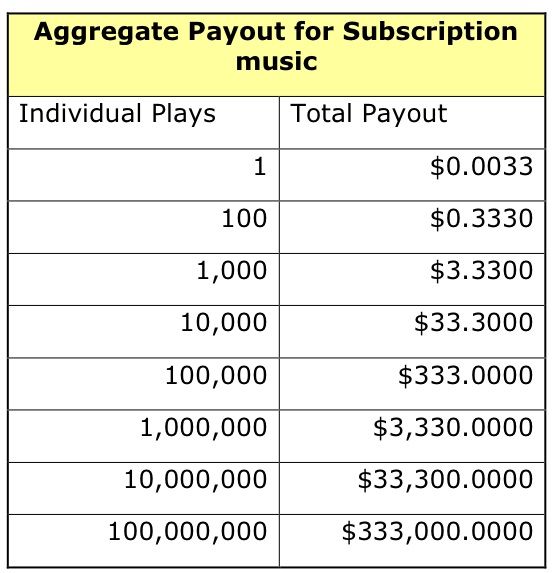
It takes 200 streams to equal the wholesale payout for one download. It takes ten million plays of a song to equal the revenue that 51,000 single downloads currently generate.
A fun game to play is to take the current singles numbers of hit songs and see how many subscription plays it would take to equal that same number. The Black Eyed Peas best selling song is “I Gotta Feeling,” which was downloaded 7.5 million times. This would generate $4,875,000 in revenue. To generate the same revenue through subscription play the song would need to be played 1.6 billion times.
This seems like a lot, but lets look at it another way. Using subscription music, what is the possibility of a song getting played 1.6 billion times in a year? At 20% adoption, every month there are roughly 35 billion plays across the services. This equates to roughly 420 billion plays a year. This means that one out of every 262 plays would have to be that song. Judging from how many time I’ve heard the Black Eyed Peas this year that may be possible.
Another way to look at it is to ask the question, “What if every person who used subscription music listened to a song once a day?” These are your hits songs, the ones you cannot escape. This is “Stairway to Heaven” in 1971. This is “Candle in the Wind” in 1997. This is “Hey Ya” in 2003.
The following table shows what the potential is for massive hit song with very moderate listening by everyone in the country.
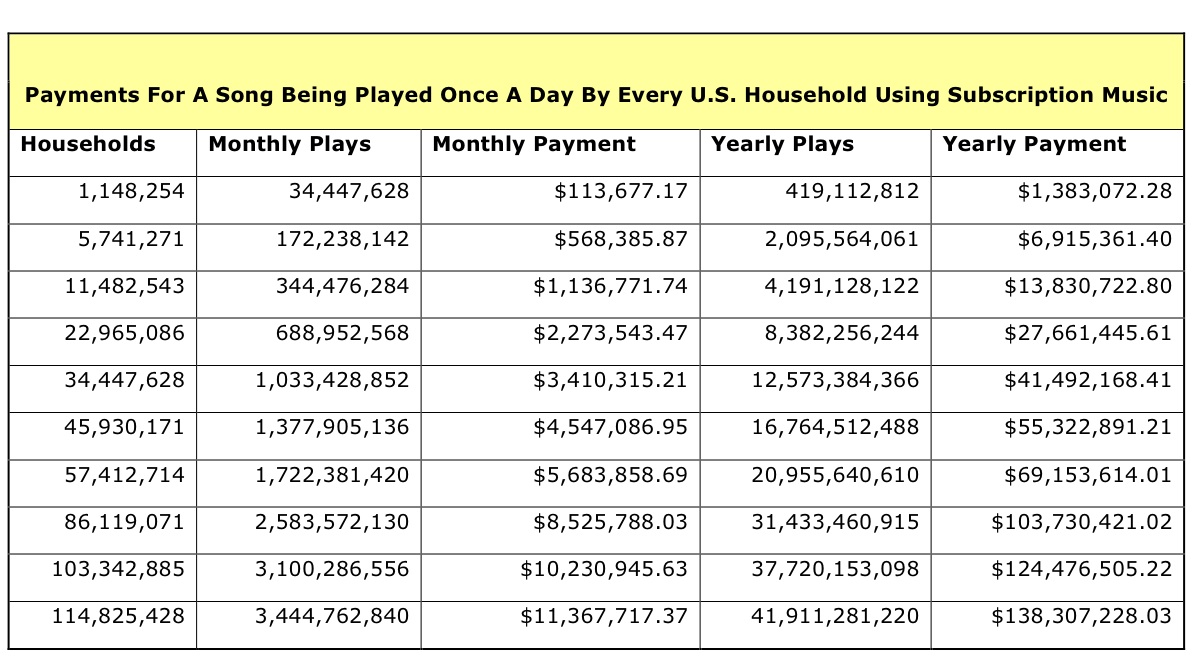
When there is a song that pervades pop culture, the potential numbers start lining up with the current revenue, and as subscription music attains larger percentages of the U.S. population, the numbers for a potential hit become significantly more than a hit song currently. Of course, the flip side of this is that there are no album sales on top of these numbers like there is currently. As subscription music becomes dominant this becomes the only recorded revenue stream.
Is a compulsory rate a sustainable business model?
The call from musicians is for more than 3 tenths of a cent, and the music industry has a history of embracing compulsory rates. One penny is the rate I have most commonly heard as fair for a stream. The next table examines what the maximum per stream royalty a subscription service can handle at different listening frequencies assuming a 100% payout. This is the maximum that a service can handle. After this point the service would be paying out more revenue than it would take in, and would shortly become unsustainable.
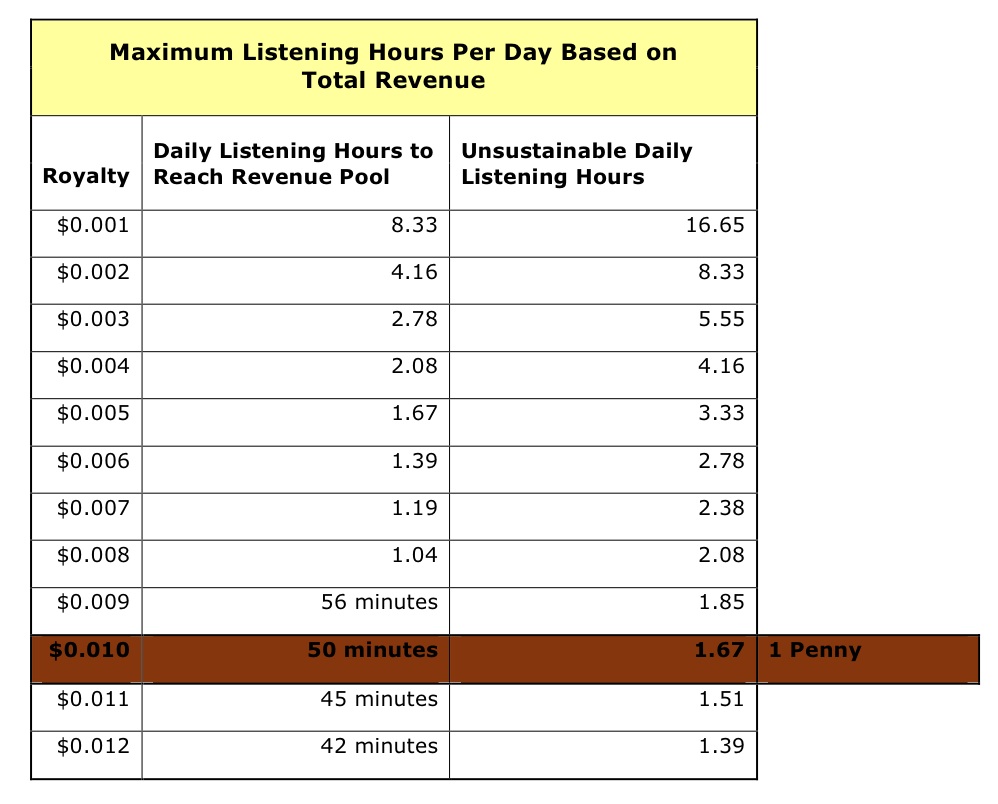
If a compulsory rate of 1 penny is mandated, then the averaging listening time for a consumer needs to be around 50 minutes a day to sustain a 50% revenue pool share. After about 1hour and 40 minutes a day the mandated royalties are more than the revenue brought in by the 10 dollars a month in fees. Another way to look at this is to think how much revenue can be paid if there was only one subscriber, and a mandated one penny per stream royalty.
9.99 subscription fee = 999 songs per month = 33 songs a day = 99 minutes of listening time. This is 1 hour and 39 minutes or 1.67 hours as the chart above indicates.
Looking at no other overhead or costs, this is the point where a subscription service can no longer physically pay out fees, although it would have went bankrupt well before then. Looking at this chart and the others, and knowing that the average listening time for music is 2.5 hours a day, .003 cents still seems to be the most likely candidate for the payment per stream.
Anything above this at the current cost per month, would bankrupt any subscription music service. To sustain a compulsory rate of one penny, subscription music services would have to increase the monthly cost to 60 dollars listeners must not exceed 2.5 hours of listening or 50 songs a day.
Conclusion
At the beginning of this essay I set out to answer 4 questions about the potential revenue and costs as the music industry switches to subscription streaming. After exploring the various scenarios, the conclusion that can be drawn is that there is significant revenue that can be generated by the services as a whole, but the individual stream payments will remain in fractions of a cent and will only decrease as the services become more popular.
Devils Advocate: Possible arguments against my claims and my responses.
Q: This does not take into account advertising revenue.
This is because premium versions of subscription services, the 10-dollar a month kind, are built on the premise of no advertising. The ad supported networks will generate even less revenue. Ads are generally sold on CPM. If an ad was sold on every play (which is not the case) a CPM of 79.82 would be required at 2.5 hours of listening to equal the same revenue as subscription services. This is extremely high for a passive audience.
Q: This doesn’t use the exact formulas the subscription services currently employ.
The formulas in this essay are based on the mathematically fairest division out there. This is the perfect scenario. The actual case will be slightly different, but as shown in numerous calculations the per-stream payment will almost always be in fractions of a cent at the current monthly cost.
Q: You are not taking into account the promotional aspect. Streaming promotes other revenue streams.
This argument is true at the lower levels of household adoption, but begins to fall apart as more people use the service. This is because as subscription music becomes the dominant medium for music consumption, there will be less and less physical or file sales to benefit from the supposed promotion. To put it another way, if everyone is getting their music from subscription music services then the only thing you are promoting is other subscription music. In regards to merchandise, tickets or any of the other ancillary revenue streams, it is true that streaming will promote them, but the current and former methods of music consumption also did that. I’d be interested to see any proof that streaming music is somehow a more efficient promoter of these other revenue streams.
Q: These calculations are based on a 50/50 split. If we increase artist revenue the per-stream payments will go up.
Yes and no. This could be true, but it again depends on the ratio. If the plays go up at a faster pace than the revenue pool is increased then the per-stream payments will not go up and possibly could go down. The compulsory sustainability section was based upon a 100% revenue pool and this is the absolute maximum that a subscription company could pay out at the current monthly costs. Looking at that you can see that subscription music is practically unsustainable after a penny a play.
About:
Frank Woodworth is a ten year veteran of the music industry and the founder of www.glacialconcepts.com. He has previously been selected to “30 under 30” music executives by Billboard magazine, and has twice spoken at the CMJ Music Festival.






Reader Comments (17)
Nice work Frank. It was quite a read but worth it.
A few remarks though:
I am a Spotify fanatic and listen a lot but I will never reach an average 2,5 hours a day. 1 hour at most.
Rhapsody pays about a penny per stream and Spotify pays me € 0.004 (about $ 0.0053) at the time. You can find a copy of my latest statement on my blog. How does that effect your calculations?
Frank, You don't seem to understand the point of streaming, which is never on the back end.
That's why majors love this model. $20 million up front and they don't have to pay artists.
Frank,
Congrats for your in-depth study on the revenues from digital services.
I also did a study entitled "Music 2.0 business model" leading to the conclusion that revenues from paid streaming services are far from being negligible for artists & labels.
They are equivalent to those obtained from download services in 3 years time based on several assumptions like an average of 23 streams/artist/fan/month.
Check it ou on http://palmrocksongs.com/publications.
Frank, what's the real conclusion to the question posed? It appears like you're saying that this can be a sustainable business model both for artists and the streaming companies, as long as user uptake is sufficiently high and an overly-aggressive minimum rate per stream isn't imposed (which can make the model unsustainable for the companies).
It's impossible not to feel sympathy for artist's tales of paltry amounts of cash for thousands of streams, but I feel like we need more data regarding changes in download sales and physical sales to truly judge the net profitability to an artist of being on such services. I'd be fascinated to see numbers around whether artists have began to get noticeably fewer or more download sales following either adding or removing their music from one of these services. Does the 'discovery' effect of these services outweigh the 'lost user' effect? It doesn't seem obvious to me which way it would go, and could be v different for indie v mass market pop.
"It takes 200 streams to equal the wholesale payout for one download."
if i download a song i love, i'm sure i would listen to it more than 200 times over the life of me owning the song.
if i stream the song the same time number of times, won't the label get paid more?
in the end, doesn't the streaming service pay out more than a digital download would based on the number of times the consumer would listen to the song?
Responses:
To spotidj - The numbers don't affect my calculations. The calculations in the essay are samples at certain levels, and the formulas are provided to calculate other scenarios. With your numbers, you could assume that the average listening time is less than the 2.5 hours I have used. This makes sense, because subscription music is currently not the dominant medium, but one of several ways of listening to music. I'm looking at an eventuality more than the current reality. As you state, you currently only listen for one hour. The short answer is If everyone listened at 1 hour like you, then a 50% revenue pool would be able to handle about 8 tenths of a penny, in a perfectly fair division.
To Jim Deez - 20 million upfront is the wholesale revenue of roughly 3 million digital albums, or 2.25 million physical albums with an SRP of 13.98. This is one superstar artist for a major label. This is not a large sum, to insure the continued stability of your business while the revenue model switches. On one hand, from a business standpoint I hope the major labels argued for more, and on the other hand I hope they did not get it, as I believe in an equal division of streams.
To Chris De Palmer: Wow, your paper looks very in depth. I've saved it to read later, and will reply then.
To Lorenzo: Your conclusion is exactly what I am saying, although I would also hope that by looking at the macro numbers artists and labels are able to better decide whether they want to participate in the services. That was the other point of the essay.
As for your call for more data around the discovery of nature of streaming. I agree with you, and wish i had access to that. However, I think that only works at low levels of adoption, and assumes streaming music consumers don't stop using other avenues of consumption at any point. If at higher levels of adoption streaming co-exists with digital downloading or some other sales format because of some technological impediment to convenient listening, then there is an entirely different phenomenon to study. If anyone has data on streaming discovery leading to sales, I'd love to see it.
Interesting thoughts. It seems that the proforma calculations that demonstrate the downstream, residual value of streaming to labels and ultimately to artists needs to be done on a 'lifetime' basis; where a song on a streaming service is 'consumed' by a fan over a lifetime of listens?
Don't rightsholders have to ask: 'which is greater a 99 cent download or 35 years worth of streaming (on a declining basis as the track ages)?
Completely agree with you Frank, and I'd like to think (hope?) that streaming services can coexist along with physical copies regardless of user uptake. To be anecdotal, I think the rise of vinyl in recent years shows a love and appreciation for the physical format that will always exist, although I could easily be proved wrong as social attitudes towards music consumption change. I for one know I'll always enjoy owning the physical product of those artists that I love. Poring over a freshly delivered box set, the lyrics book and the artwork, is a feeling that can't be matched through a few double clicks. Now where the artists generate revenue from is a very different question.
Responses:
To Anthony:
There is a chart in this essay that shows how popular songs can earn more than they would get from downloading. So we agree on that point, there are songs that could conceivably make more money from streaming then from downloading. I just don't think there are many that will. Humor me with an experiment.
Please go to your itunes library and sort by plays. Then tell me (or just learn for yourself)
1)How many songs you have in your library
2) How many songs you paid for ( this eliminates the streaming is better than piracy argument)
3) how many songs you have paid for that have been played more than 200 times.
To Bruce:
I've been thinking a lot about this. The issue I have with the individual comparisons of downloading to streaming is that they occur in a vacuum and don't take into account opportunity cost. Every time someone listens to one song it is time that is not spent listening to another. I only have a small portion of my music collection in my itunes at 1,175 songs, or about 110 albums, and itunes informs me that is equivalent to 3.2 days of listening time. It would take me 640 days or a little under 2 years of non stop music streaming to equal the same amount of money generated from downloading. I keep my itunes on shuffle for about 8 hours a day. So it would take me closer to 6 years of listening 8 hours a day to make sure each song equals the value of one download. In your 35 year scenario I pay 6 times more then I would for a download.
This sounds great, but does not stand up to the holistic view of the streaming ecosystem. The 200 multiple I use depends on $.0033 royalty which assumes 2.5 hours of listening of listening a day. If everyone was spending 8 hours of listening to feasibly get to all of their songs more value than a download the variable rate would be closer to $.0001. Now it is 600 streams to equal one download or 18 years of only listening to my 100 albums for 8 hours a day. Glenn Peoples at Billboard did a great article about this several years ago.
Then opportunity cost comes in. The current 1,175 songs are the only ones I can listen to for the next 35 years. 100 albums for the next twenty years. I just don't think it is practical from a quality of life standpoint.
If you replace the variable rate with a compulsory rate, and everyone is listening to music enough to have streaming equal downloading, then the streaming services cannot generate enough revenue to equal their required payments to artists. This is illustrated with my last chart.
Everything has to be looked at together. It can be spun one way or the other by ignoring certain variables, but the fact is there is only so much time in a day, and there is only so much money to go around. This isn't necessarily good or bad. It just is.
Thanks Frank. Good points. Reminded me of this post I wrote here some time ago.. http://www.musicthinktank.com/blog/the-unprecedented-shift-from-multiplication-to-division.html
Perhaps a better model would be to initially pay out 1c per stream and then scale down the payout as the number of listens increases. This would be more supportive of artists but still allow big hits to generate decent revenue.
The newest research I've seen on music discovery (though it was published before Spotify was here in the US) puts all online streaming way below things like traditional radio and word of mouth from friends. Check it out. http://www.edisonresearch.com/Infinite_Dial_2011.pdf
http://www.edisonresearch.com/?s=music+discovery
Note on assumed number of streams per hour: not quite inside information (take it from someone knowledgeable about > 2.5 Million streams a month), the average song length is 4 minutes or 15 songs an hour, not 20.
Hey, surely the revenue per stream not a constant, as if people listened 30 minutes, then the percentage of say Lady Gaga songs streamed against total streams would still be the same even if people listened 2.5 hours or even 24 hours. This is assuming percentage of streams = percentage of revenue pool
To Nicholas - I never say it is, The per stream revenue is the result of a 3 variable equation. If you change any of those variables then everything else changes.
Its not practical from a publishing standpoint to run every scenario in tables, but I provide the equations if you would like to do so, and even clarify in the article in the below quote how the revenue per stream changes at each level of listening. -
"The interesting thing about this equation is that because plays increase by the same factor as revenue, the ratio remains the same. The per-stream royalty is still the same 1/3 of a penny. There are two ways to increase the per stream royalty. The first is the per-stream royalty will increase if as more people adopt the service the number of plays decreases as they do. This would require the service to be used less as it gets more popular. This is the gym membership model. The per-stream royalty can also increase if the distributed revenue increases. This is possible if the overhead required to run a subscription company does not increase at the same rate as subscriber acquisition, and the extra money is added to the revenue pool."
To Pete:
Thank you for the info. You are right the per song number average is 4 not 3 and it keeps rising each decade http://thelister.blogspot.com/2011/07/average-pop-song-length-by-decade.html
However that has very little impact on the numbers. As the essay worked on formulas and my examples are just one of a multitude of outcomes based on those formulas then it really doesn't matter.
Inputting your number the per stream rate comes out to .0044 based a 50% revenue split. Spotify claims to pay out 70% so that would bring it up as well. from .0044 to .0062
All of the numbers can change, as they are formulas, What will not change though is that total revenue will be based on users multiplied by cost of service, and per stream revenue will go down the more people listen.
I'm not saying that streaming is worthless ( quite the opposite in fact) I'm saying that per stream revenue is very unlikely rise above a penny if it becomes the dominant form of music listening with todays current listening habits.
One last thing to Nicholas and Pete,
Lets say a million people pay 10 bucks a month for a streaming service, and for some reason only one person listens to one song in that entire time. Well then the per stream revenue for that one song is 5 million in my 50/50 model or 7 million based on what spotify currently pays out. Is this likely, no.
So again while higher per stream rates are possible and i can throw out a million other less rediculous scenarios that result in high rates per stream, they are unlikely.
I invite you to play around with formulas provided, and see what different scenarios will result.
Thanks Frank for your additional info. I also got a lot of 'what if this, what if that' questions. I have published a :Spotify Royalties Calculator so everybody can play around with the numbers